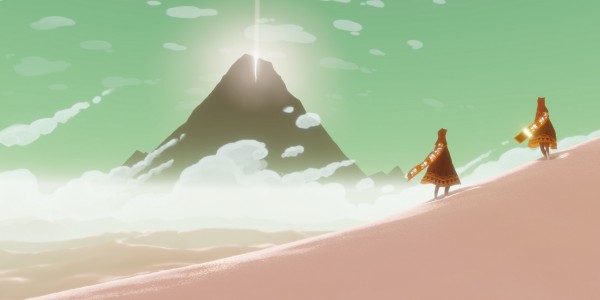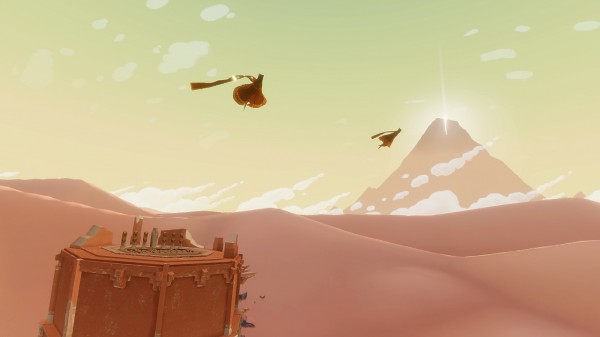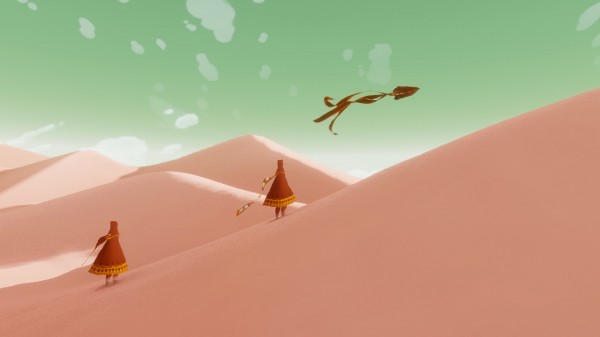Minimalist art is the most and least accessible form of art; it’s so uncomfortably primal. It demands intimacy, and that the viewers become active participants in its emotional experiment, like, for example, in William Carlos Williams’ take on aging: “It is not fair to the old, to put on a brown sweater.”
So, for the gamer uninterested in empathy, thatgamecompany’s minimalist downloadable title Journey will beat against a stubborn will. Those susceptible to Journey (spoiler alert: me) will find the red-hooded hero (perhaps the asexual hero or heroine – there is something lithely feminine about its graceful jaunt) laying the first emotive brick alone in a desert, discovering the first of three play mechanics.
The steps of my shrouded avatar are slow and governed by the environment. The artistically aquatic sand splashes underneath the wanderers gait. A steep incline reduces the pace of movement until it’s mounted. Once crested, sliding down the dune’s reverse side introduces the game’s innocent playfulness. This feels like surfing.
A distant mountain, a celestial light shining from its peak, a barren sandy waste, and a figure goofing around the scene in play – it’s an apt distillation for a videogame, and highlights well the nuanced movement system. Rather than allowing the player to trounce powerfully across an indifferent landscape, Journey presents a dead, forcible, reactive world subsuming an ant. And despite my pretentious, intellectual prodding, Journey never lapses into pretension. Its messages are as effortless and clean as the experience of playing it.
A game has moved me with its first design decision.
At the base of the dune I find Journey’s second mechanic: singing. By pressing circle, I elicit a tone from the crimson wanderer, accompanied by a white aura and glyph. I press circle three more times to make sure I haven’t used it up. Then twenty times fast. It appears to be infinite. I imagine the sense of loneliness in singing to an audience of sand. The song does not change, and the singer does.
It’s only after I discover a spark hovering above a decrepit, sand-beaten pedestal that I learn the value of my song. The spark knits a small scarf about the wanderer’s cloak. X-button, and the figure takes flight, brought down to the sand shortly after. The scarf is depleted of its luminous levitating glyphs, so I trek to a nearby stone block, drawn by the specks of red cloth swimming above it. I sing; they glow with me, replenishing my scarf and carrying me skyward. They are the first of many cloth creatures in Journey, all of whom respond to the song and touch of the wanderer.
How curious for a player’s primary ability to be voice. Like Williams’ brown sweater, it’s a representation of a diverse pool of experiences. The voice is a tool for communication, for connecting two entities that understand it. It is not a tool of domination – simply of being heard.
It’s in this wanderer/ruins/sand/sand/sand/cloth-bird orchestra that I’m joined by an unexpected, sentient partner (a randomly assigned player online, voice chat and PSN ID disabled). Also cloaked in red, the figure squeaks its glyphs towards me. Its glyph is oddly-shaped (and so third millennia) but of similar capacity. In fact, both our glyphs regenerate the other’s scarf.
“So there is power in communication, in collaboration,” I think. More than that; there is a wordless friendship in our chance union.
I’m not amused with the other’s distinct lack of direction after five minutes of aimless greeting. “Well, on we go,” I say to its blinking face. It glyphs at me twice. I walk towards the mountain, saying, “No, c’mon, this way.” It runs back to the gaggle of cloth, glyphing and jumping in place. I stand beneath it stamping my virtual foot. It doesn’t seem to notice. “I’m going on without you. Don’t call me. We’re through.” I tramp off into a sulky temple ruin.
Later on, in a dark, dusty cave I’m joined by a new companion. I can tell it’s not the same idiot from before, because the glyph is different. This one is less presumptuous, adorned by less gaudy elegance. By now, I’ve learned that my voice is limited to a particular function, and does not adequately communicate my superb leadership or direction. So our partnership continues in relative, indifferent silence.
When we are confronted by a living enemy, my partner reveals its secondary use. Hiding in cover, I urge it forward into the weak shafts of visible light. The sheep obeys and is pummeled by the beast for its bravery. I sneak by in the shadows unharmed. And alone.
A final partner joins me in my most trying hour. Without impetus or presumption, it warms me with its exhausted gasps of glyph. I return glyph. We huddle closer as the cold surrounds us and frost builds on our wind-beaten scarves. Here I learn the value of cooperation, the necessary selflessness of the cooperative mechanic. The angry mountain, I now find, can be scaled together. (Soon after, I also sacrifice this partner to a rock monster, but feel some guilt this time.)
Journey’s concentrated, abstract landscapes are sufficient to call it a worthwhile visual vacation, but it’s the unexpected variable of contact with free will in concert with the environments that cuts me deep. As the canon of minimalism, the game draws its strength from the purity of its elements. Jumping is not adorned, but meaningfully tied to the interaction of player voice. The voice is not so complex as to take the form of a broadsword, snowboard, or a dialogue tree. The voice is a voice.
“How primal is the need to connect,” I wonder, “that it can propel Journey for ninety minutes without pause? How separated must we now be, how isolated, that we long for so base a communication?”
Journey escapes magnanimity and erudite ho-humming (unlike this review) by focusing its attention back onto the player. It’s a game that depends on the user’s emotional and mental input, and that does not reward skill or punish inexperience, but paraphrases the imperfect diversity of human nature, manifest in world and wanderer. Forget the “games as art” debate; begin “choice as art”.




















